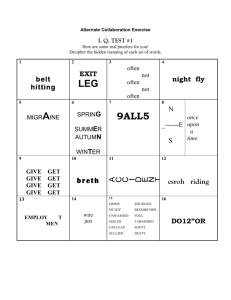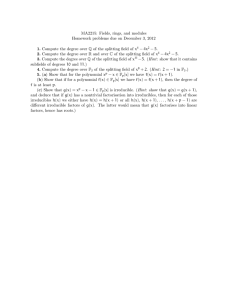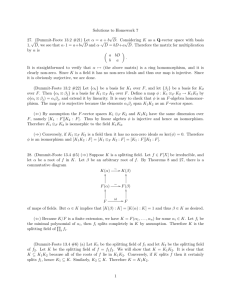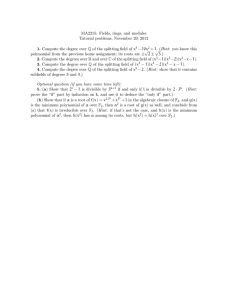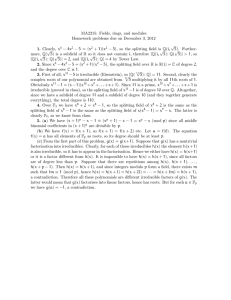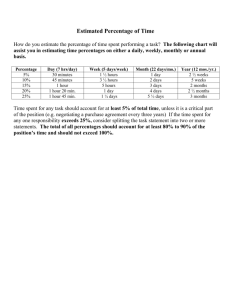Optimal Heuristic Planning using Search Space Splitting
advertisement
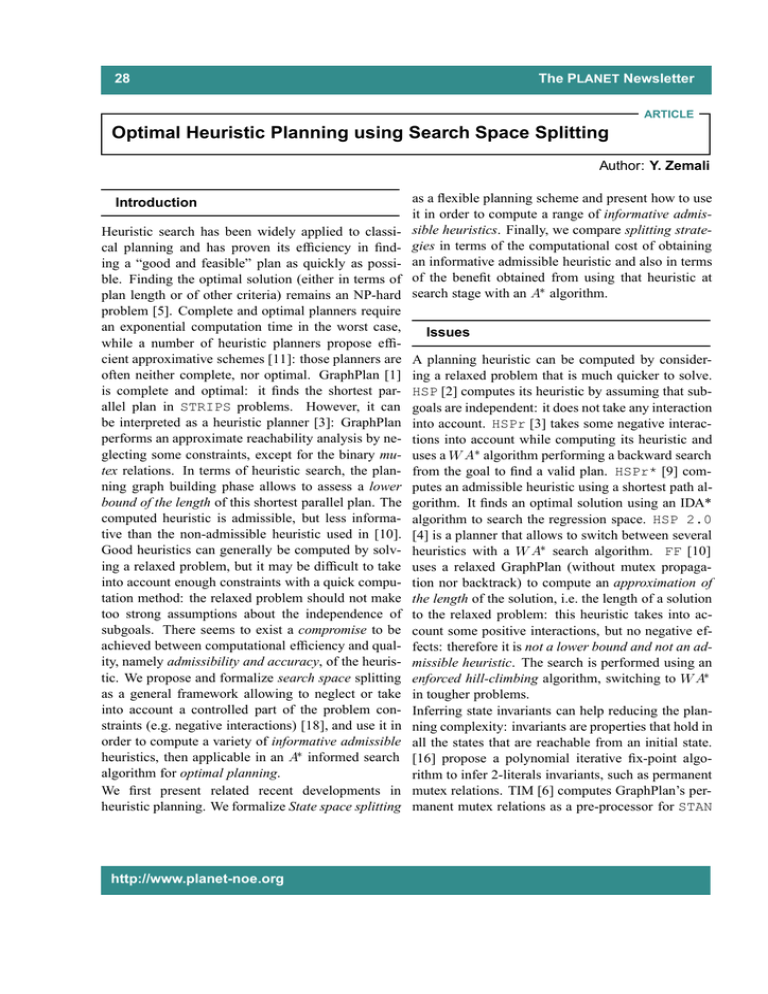
28 The PLANET Newsletter ARTICLE Optimal Heuristic Planning using Search Space Splitting Author: Y. Zemali Introduction Heuristic search has been widely applied to classical planning and has proven its efficiency in finding a “good and feasible” plan as quickly as possible. Finding the optimal solution (either in terms of plan length or of other criteria) remains an NP-hard problem [5]. Complete and optimal planners require an exponential computation time in the worst case, while a number of heuristic planners propose efficient approximative schemes [11]: those planners are often neither complete, nor optimal. GraphPlan [1] is complete and optimal: it finds the shortest parallel plan in STRIPS problems. However, it can be interpreted as a heuristic planner [3]: GraphPlan performs an approximate reachability analysis by neglecting some constraints, except for the binary mutex relations. In terms of heuristic search, the planning graph building phase allows to assess a lower bound of the length of this shortest parallel plan. The computed heuristic is admissible, but less informative than the non-admissible heuristic used in [10]. Good heuristics can generally be computed by solving a relaxed problem, but it may be difficult to take into account enough constraints with a quick computation method: the relaxed problem should not make too strong assumptions about the independence of subgoals. There seems to exist a compromise to be achieved between computational efficiency and quality, namely admissibility and accuracy, of the heuristic. We propose and formalize search space splitting as a general framework allowing to neglect or take into account a controlled part of the problem constraints (e.g. negative interactions) [18], and use it in order to compute a variety of informative admissible heuristics, then applicable in an informed search algorithm for optimal planning. We first present related recent developments in heuristic planning. We formalize State space splitting http://www.planet-noe.org as a flexible planning scheme and present how to use it in order to compute a range of informative admissible heuristics. Finally, we compare splitting strategies in terms of the computational cost of obtaining an informative admissible heuristic and also in terms of the benefit obtained from using that heuristic at search stage with an algorithm. Issues A planning heuristic can be computed by considering a relaxed problem that is much quicker to solve. HSP [2] computes its heuristic by assuming that subgoals are independent: it does not take any interaction into account. HSPr [3] takes some negative interactions into account while computing its heuristic and uses a algorithm performing a backward search from the goal to find a valid plan. HSPr* [9] computes an admissible heuristic using a shortest path algorithm. It finds an optimal solution using an IDA* algorithm to search the regression space. HSP 2.0 [4] is a planner that allows to switch between several heuristics with a search algorithm. FF [10] uses a relaxed GraphPlan (without mutex propagation nor backtrack) to compute an approximation of the length of the solution, i.e. the length of a solution to the relaxed problem: this heuristic takes into account some positive interactions, but no negative effects: therefore it is not a lower bound and not an admissible heuristic. The search is performed using an enforced hill-climbing algorithm, switching to in tougher problems. Inferring state invariants can help reducing the planning complexity: invariants are properties that hold in all the states that are reachable from an initial state. [16] propose a polynomial iterative fix-point algorithm to infer 2-literals invariants, such as permanent mutex relations. TIM [6] computes GraphPlan’s permanent mutex relations as a pre-processor for STAN The PLANET Newsletter [13]: it generates finite state machines for all the possible transitions for each single object in the domain. Yet, the benefit of pre-computing permanent mutex relations appears as not significative enough in GraphPlan-like approaches, such as in [7] or [14]. A generalization to other invariants is proposed in [17] and in the DISCOPLAN package [8] which uses syntactic properties of the operators to verify whether the truth of an invariant is preserved. Such invariants or properties of the domains can rather be used in order to speed up heuristic computation. “Hybrid” planners efficiently combine both approaches : AltAlt [15] computes its heuristic using the planning graph produced by STAN, and searches from the goal with HSPr’s regression algorithm. States and facts The duality between state-based and fact-based representations is classical: a planning problem can be described either with a model based on enumerated states or with a model based on facts that can be true of false. Both representations characterize the same state space: enumerating all the possible combinations of truth values for the facts gives the set of all possible states. Each fact corresponds to the set of states in which it is true. Each list of facts corresponds to the set of states in which all the facts are true (the intersection of the sets of states corresponding to each individual fact). State-based model In a state-based model, actions are defined as transitions between individual states: in each state, an action can either be executable, leading to another state ¼ , or not. The state-based model of a planning problem is defined by: 29 – either an impossibility symbol if the action is not executable in the state – either the state ¼ resulting from the execution of action in state ¼ . Fact-based model In a fact-based model, actions are defined as operators that make some fact true and other fact false, provided a number of facts that have to be true for the action to be executable. Each action is defined by: a list1 of preconditions , that is to say the facts that have to be true for the action to be applicable; a list of deletion , that is to say the facts that are made false by the application of the action; a list of creation , that is to say the facts that are made true by the application of the action. An operator defines a macro-transition from a list of facts (a set of states) to another list of facts (another set of states): The fact-based model of a planning problem is defined by: a finite set of facts describing the properties of the possible states ½ ¾ a finite possible actions set ½ ¾ a transition function associating each couple – either to an impossibility symbol if ’s pre . conditions do not hold in , i.e. – either to the set of facts resulting from in the the execution of action states where facts hold , with We define the set as the set of relaxed actions (actions obtained from by neglecting the delete a finite possible actions set ½ ¾ lists). We have: and a transition function ! . We note associating to each couple (state, action) : the associated transition relation. a finite possible states set ½ ¾ 1 in GraphPlan parlance, list means set (no ordering between the elements) 30 The PLANET Newsletter Disjunctive transition relation ·½ ¼ ·½ ·½ ¼ ½ The planning can either be done from the problem ·½ ¼ ¼ ½ Search space definition or after an exploration phase that builds the graph of the search space. Depending on how it handles facts or states and how it develops the transition relation between them, a planner will not build the same search space nor explore it in the same way. The classical duality between facts and states is the basis of our formalization of a variable state space splitting in the building and exploration of the reachable states at planning time. Tree search space at state level In a tree search space, all the nodes of the explored tree correspond exactly to individual states . The nodes are connected by the possible transitions between states. The transition relation between the explored nodes in an tree search space is directly given by the transition function of the state-based model. is the successor of in the search tree and in the transition relation , if and only if there exists an action that realizes a transition between these two corresponding states. Developing such a transition relation gives the tree of a Forward State Space search. ¼ State-based transition relation ¼ ¼ Disjunctive search space In a disjunctive planning approach, the nodes of the search space are the levels, which correspond to the notion of depth in a tree: there is only one node by depth. The successor node ·½ at level " is the set of facts #¼·½ #½·½ #·½ ·½ built by developing all the transitions that are applicable from the set of facts of its predecessor node #¼ #½ # at level " (taking mutexes into account). The transition relation between the nodes of a disjunctive planning graph is deduced from the transition function of the fact-based model: http://www.planet-noe.org A splitted search space? The idea of search space splitting is to reintroduce a controlled tree structure in a disjunctive search space by grouping the facts at each level " in different nodes instead of one undistinguished set of facts . For that purpose, it is necessary to split the level into different nodes constitutive of the tree structure. This can be done in many ways over the set Ä of subsets of , and in particular the splitting need not be a partition. On the contrary, useful splitting strategies are more likely to let each fact belong to a list of nodes, or classes: Classes: at each level " , the facts of are grouped into a finite number of subsets that we call classes with indexes $ . Each class in a level " corresponds to a node of depth " in the tree of the search space. The set of all classes at a level " is denoted ¾ . is a covering of . How to split the planning graph The splitting strategy defines the rules for creating and propagating classes, thus associating each class at a given level with its successor classes at the following level. In that sense, the splitting strategy is the “branching rule” of the tree structure introduced in the planning graph. Classes are defined while building the search space as a tree. Splitting strategy: if is a class creator, otherwise. The splitting strategy consists in determining which actions will create a new class when they will be applied. Those actions will be applied through (their delete lists will be taken into account). Other actions will be applied through (as relaxed actions, i.e. without their delete lists). From a departure class , an action is applied in the following manner: The PLANET Newsletter 31 if ·½ where % is a new index for the created class; Getting informative admissible heuristics if ·½ where In GraphPlan, the number of levels of the planning is the relaxed action corresponding to graph (when the goals are first reached) may be a very poor estimation of the exact length of the solution: in the action . this building phase, GraphPlan relaxes a number of constraints. It groups together incompatible facts into sets (levels) that contains a number of incoherences. On the contrary, a full splitting approach (a tree exploration) will separate each individual state during the graph construction. The depth of the planning tree when the goals are first reached, will give the exact length of an optimal solution. GraphPlan’s approximation is too coarse (too short). A tree exploration will compute a perfect heuristic, but in an exponential time. Figure 1: Splitting process for the gripper domain We use state space splitting in order to achieve a comThe resulting transition relation in the search space promise between those two extremes: our heuristic is connects two nodes, i.e. a couple of two classes (de- classically computed by solving a relaxed problem, parture, arrival) of two successive levels, if and only i.e. having neglected some constraints, but uses the if, for all facts in the arrival class: number of levels of the splitted planning graph. there exists an action whose preconditions are all Splitting the planning graph allows us to better aptrue in a same departure class and that has this fact proximate the real plan length (see also [12]), taking more negative effects into account in a controlled as an effect in the arrival class; way: a number of incoherent sets of states can be the application of this specific action in the de- splitted, and more constraints of the problem can be parture class effectively leads to the arrival class taken into account. As a consequence, some operaaccording to the splitting strategy. tors will not be introduced as early as in a GraphPlanlike building phase. Therefore, the length of the planThis transition relation not only requires that the facts ning graph (when it first reaches the goals) is inin each class are connected by the fact-based transicreased getting closer to the real optimal plan length. tion relation or , but also that this is coherent Yet, we are still underestimating the exact plan length with the splitting strategy. because not all the constraints are taken into considSplitted transition relation: ·½ eration. The length of the splitted planning graph is a if ¼ more informative admissible heuristic. if ¼ ·½ ¼ ·½ ¼ ¼ A no splitting approach ( ) corresponds to a GraphPlan behavior. A full splittin approach ( ) corresponds to the behavior of a Forward State Space planner. Splitting on the number of permanent mutexes Our splitting strategy is based on mutual incoherence, or interactivity, between facts. At each level, facts are grouped according to their level of mutual coherence 32 with respect to the problem constraints: facts created by operators that are not mutex with each other can be grouped in a same class. In practice, operators with a big interaction degree (this is the number of instantiated operators with which the current operator is permanently mutex) are marked as “class creator”. A number of algorithms allow to compute invariants features such as permanent mutexes in a planning problem. We designed an algorithm, devoted to the detection of permanent mutex relations, which considers facts as resources [14]: if two operators destroy the same fact, they are mutex because they try to consume the same resource, which is not possible. Our algorithm takes advantage of this by coloring the facts. Two facts with a common color are mutex because they result from the consumption of a common resource. This marking allows to know if two facts need competitive resources to be produced. The two first steps of the algorithm are to determine the number of colors per fact, and to create the initial colors which will be used to create new color combinations. The creation of the first (primary) colors is deduced from the “initial state” of the problem. Thus, we can give a (or several) different color to each fact of the initial state because those facts are not permanent mutex between each other. Our algorithm then propagate the primary colors until all facts are colored. We do not detail the propagation process. From the mutex relations between facts, we deduce the mutex relations between operators to compute the interaction degrees. Implementation details In our planner, the user has to provide a splitting level. This is a percentage which determines how many operators will be class creators. Those operators are then determined by the splitting strategy. At each call of the heuristic function &, the algorithm needs to assess sets of states. During the successive calls, the algorithm may assess several times the same set. To avoid this, we need to store intermediate valuations of sets obtained during & computations. A set of states is described by facts: if is the number of http://www.planet-noe.org The PLANET Newsletter facts of the problem, each set is described by a vector ' , where ' $℄ gives the truth value of the $ fact. The vectors are stored in a decision tree (DT) where leaves contain the & intermediate valuations. Formally, we have . Thus, we can read and write intermediate values in a constant time hand coded strategy . This mechanism allows us not to recompute & from scratch. If during & computation, the algorithm reaches a branch where it has to assess a set which is already being assessed at a lower depth, the branch will be cut. To detect such branches, we also use a method based on decision trees. Figure 2: visited states for the gripper problem: instance with 6 balls Thanks to those mechanisms, our planner behaves like a dynamic programming algorithm when used with a full splitting. This allows to study a continuum between the resolution with a relaxed GraphPlan heuristic (no splitting) and with a dynamic programming approach. With the intermediate splitting levels, more or less constraints are taken into account in the heuristic computation. Results on the Gripper domain We solved this problem with two splitting strategies: the automatic one, described above, and a hand coded one, in order to study the impact of the strategy. We tried a range of splitting percentages from 0% (then the heuristic computation is equivalent to a relaxed GraphPlan) to 100%. As expected, the number of visited states decreases when the splitting level increases. Figure 2 shows the relation between The PLANET Newsletter the splitting level and the number of visited states for both strategies. The automatic splitting strategy (dashed edge) is deduced from the pre-computed permanent mutexes. The operators with the greatest interaction level are the “move” operators. As a result, they are preferentially “class creators” (Figure 1). Our hand-coded strategy does exactly the opposite: “pick” and “drop” operators are preferentially responsible for splitting. The automatically deduced strategy visits the search space in a more efficient way. This is due to the fact that when we do not split on move operators, we propagate a lot of incoherence, because move operators are very interactive and generate numerous mutex relations. Results on the Blocks World domain This time, the automatic strategy is equivalent to a random splitting because each operator has the same interaction degree. As a result, there is no preferentially chosen operator to be responsible for splitting. By hand, we privileged the “pick” operators to be responsible for splitting. The hand coded strategy is here the best one. This is because this strategy manages to capture -literals constraints between facts with (mutex only correspond to ). Figure 3: CPU time for the 5 blocks problem Concerning overall CPU time, on a five blocks instance, we can see that the two extremes (relaxed GraphPlan and dynamic programming) give the best results (Figure 3). For a splitting level between 0% and 50%, the number of visited states decreases, but the heuristic computation time increases: we do not 33 have any benefit from the splitting. From 50%, the overall CPU time starts to decrease. This is due to our intermediate results storage. With such splitting levels (50% to 100%), the heuristic becomes very informative. The search algorithm then focuses in one direction. Therefore, previous stored results will be reused. With too small splitting levels, there are too much changes of direction for the intermediate storage to be used efficiently. We verified this intuition empirically by studying the ratio number of elements read in the DT / number of elements stored in the DT. This ratio reflcts the utility of our storage. If ( , the storage mechanism is not very useful: there are less read elements than the total amount of stored elements in the DT. If ) , there are more read elements than the total amount of stored elements in the DT. This means that we can avoid unnecessary computations: some elements are read several times in the DT, rather than being re-computed several times. For the 5 blocks problem, remains lower than 1 up to 50%, it then slowly increases from 1 to 3 for a 100% splitting. Conclusion and Perspectives We proposed and formalized search space splitting. We presented its application to compute admissible heuristics for optimal planning. The search space splitting aims at increasing the quality of the heuristic. The more we split, the more the heuristic gives a length close to the reality. One of our future work is to optimize the splitting level in order to minimize the global complexity of the planning process: this level is a parameter given by the user, and we are working on how to deduce it automatically. We presented an automatic splitting strategy which appears to be efficient (in terms of reducing the size of the search space) in the general case. However, the blocksworld example proves us the existence of better strategies in certain cases. We are working on a way to automatically adapt the splitting strategy to the domain. Our method is efficient with extreme splitting levels (close to 0 or 100) on small dimension problems. With bigger dimensions, too small 34 splitting levels give a poor estimation, thus leading the search algorithm to make a too vast exploration. Our first experiments show that problems with high dimensions should be tackled with a high splitting level. Of course, we can not handle those problems with a full splitting, because it would be equivalent to solve them with a dynamic programming algorithm, which is not applicable with huge dimensions. Quite high splitting levels (60 to 90) could relax the problem enough to break the complexity while giving an informative heuristic. The search algorithm would then concentrate its exploration on a few privileged directions, because it is well informed. But, this leads to storage problems: there are too much intermediate results to store in the DT. To handle this, we envision using tree reduction methods issued from the Multi Terminal Binary Decision Diagram domain. We expect those methods to help us dealing with tougher problems: the splitting provides a mean to control the accuracy of the heuristic which could help to explore greater search spaces in an efficient manner, or to deal with optimization criteria richer than the plan length (PDDL 2.1). Bibliography [1] Blum, A., and Furst, M. 1997. Fast planning through planning graph analysis. Artificial Intelligence 90(1-2):281-300. The PLANET Newsletter [7] Fox, M., and Long, D. 2000. Utilizing automatically inferred invariants in graph construction and search. In AIPS-00, 102-111. [8] Gerevini, A., and Schubert, L.K. 2000. Discovering state constraints in DISCOPLAN: Some new results. In AAAI/IAAI, 761-767. [9] Haslum, P., and Geffner, H. 2000. Admissible heuristics for optimal planning. In AIPS-00, 140-149. [10] Hoffmann, J. 2001. FF: The fast-forward planning system. AI Magazine 22(3):57-62. [11] Hoffmann, J. 2002. Local search topology in planning benchmarks: A theoretical analysis. In AIPS-02. [12] Kambhampati, S.; Parker, E.; and Lambrecht, E. 1997. Understanding and extending graphplan. In ECP-97, 260-272. [13] Long, D., and Fox, M. 1999. Efficient implementation of the plan graph in STAN. JAIR 10:87-115. [14] Meiller, Y., and Fabiani, P. 2001. Tokenplan; a planner for both satisfaction and optimization problems. AI Magazine 22(3):85-87. [15] Nigenda, R.; Nguyen, X.; and Kambhampati, S. 2000. Altalt: Combining the advantages of graphplan and heuristic state search. In KBCS00. [2] Bonet, B., and Geffner, H. 1998. Hsp: Heuris- [16] Rintanen, J. 1998. A planning algorithm not tic search planner. In Planning Competition of based on directional search. In KR-98. 617-624. AIPS-98. [17] Rintanen, J. 2000. An iterative algorithm for [3] Bonet, B., and Geffner, H. 1999. Planning as synthesizing invariants. In AAAI/IAAI, 806-811. heuristic search: New results. In ECP-99, 360[18] Zemali, Y.; Fabiani, P.; and Ghallab, M. 2001. 372. Using state space splitting to compute heuristic [4] Bonet, B., and Geffner, H. 2001. Heuristic in planning. In PLANSIG-01. search planner 2.0. AI Magazine 22(3):77-80. [5] Bylander, T. 1994. The computational complexAuthor Information ity of propositional STRIPS planning. Artificial Intelligence 69(1-2):165-204. Yacine Zemali ONERA / DCSD – Centre de [6] Fox, M., and Long, D. 1998. The automatic in- Toulouse 2 avenue Edouard Belin BP 4025, 31055 ference of state invariants in tim. In JAIR, 367- Toulouse cedex 4, France zemali@onera.fr ¾ 421. http://www.planet-noe.org
